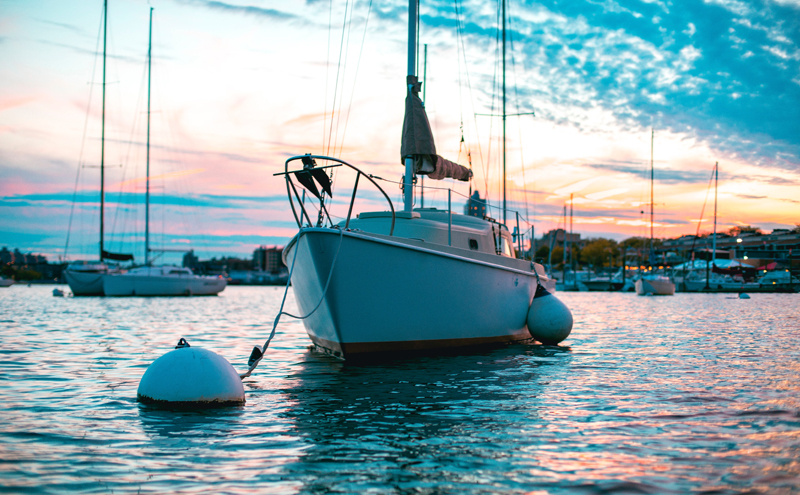If you’re a boat owner or you’re thinking of getting yourself a new boat, then this article is for you.
You don’t want to tie your boat in the wrong place. You’ll be facing huge problems because you’re not following the law.
The only answer to this question will be the “Mooring Buoys”. You’ll also need to be aware of other places as a lighted buoy, safe water marker, and non-lateral marker.
In this article, you’ll find out where it’s legal to tie up your boat.
Let’s dive in!
What Is a Mooring Buoy?
A buoy is a floating object that’s used in the middle of the sea. It’s used as a locator or a warning point for other ships. It’s usually bright in color.
A mooring buoy is used to tie ships in the middle of the water and it’s heavier than other buoy types.
It’s designed to have a heavyweight located at the bottom of the sea. The weight acts as an anchor to hold the buoy.
Loops or chains are also attached to the mooring buoy’s top part, and the boats are attached to these chains.
How to Use a Mooring Buoy?
It’s essential to use the mooring buoy properly to avoid ruining your vessel. Follow these steps for easy access.
- Direct your boat to be in a position where you can clearly see the buoy.
- Use the boat hook to catch the pick-up line.
- Pass the boat’s bowline through the pick-up line.
- Cleat the ends of the bowline to the bow of your boat.
- Avoid tying the pick-up line directly to your boat.
- Don’t stern tie to the mooring buoy because it will be dangerous to the boat.
- When you’re done tying your boat, double-check that the buoy is holding well.
Why Are Mooring Buoys the Best Option?
Mooring buoys are used to protect coral reefs because traditional anchors dig and destroy them. This helps protect marine life.
Therefore, mooring buoys have fulfilled their purpose effectively. You’ve secured your shop in its place, and you’ve done to harm to marine life.
A mooring buoy is preferred to the traditional type of anchors because it raises awareness towards environmental protection. In the following years, mooring buoys will be the most prominent equipment in the shipping industry.
Other Buoys to Avoid
You should be aware of other buoys available that are illegal to use. These include:
Safe Water Marker
These have different color patterns than mooring buoys. They’re white with red vertical stripes. Safe water markers are also called fairway buoys. They’re used to refer to the end of a channel, so boaters know that safe and deep waters are ahead of them.
Non-Lateral Markers
These markers are used for navigational aid and they give boaters valuable information. The most common type is regulatory markers. They’re white with orange markings and black letters.
Square symbols refer to the places to find food and supplies, give directions, and other information.
A circle symbol refers to a restricted area. For example, they show the speed limit or no fishing spots.
The crossed diamond symbol refers to an area prohibited by all vessels. The diamond symbol is used as a warning against rocks, constructions, or other unsafe objects.
Regulatory Buoys
These are white buoys with two horizontal orange stripes and in between, there’s a circle or a diamond shape.
They’re designed to inform boaters of restrictions or dangers they’re approaching. Different shape or symbol are used as follows:
- An open diamond refers to danger.
- A crossed diamond signifies an area that you may not enter.
- A circle indicates an upcoming restriction, such as a speed limit.
- A square or rectangular shape is used for conveying instructions.
Some Important Terms
There are some important terms that you should be aware of. Some of these are:
Bow lines: These stop the bow of your boat from moving side to side. It also keeps the boat from drifting away.
Breast lines: These are used to make it easy to pull the boat when boarding.
Stern lines: They prevent the stern of a boat from moving and avoid drifting the boat when it’s tied.
Cleats: It’s a T-shaped piece or a horn that’s designed to secure lines.
Consider the Following
Using a mooring buoy safely is key. Here are some things to consider:
- Never motor directly through the shallow reef to get to a buoy.
- Maintain idle speed when you’re near the mooring buoy.
- Watch out for swimmers and diver bubbles.
- If you don’t have your own buoy and didn’t find one, anchor, only in the sand and avoid corals.
Mooring Maintenance
Mooring buoys should be lifted every year and inspected for corrosion. Commercial moorings are well maintained and usually repaired in case of damage.
Moorings laid by yacht clubs aren’t checked so often unless the club has a lifting barge. On the other hand, moorings laid by private individuals may never get any maintenance.
If you’ll use a mooring that doesn’t belong to you, you should always check it first.
Conclusion
It’s important to know all about safe places to tie your boat to avoid any penalties. A mooring buoy is the only safe and legal option.
Follow the simple instructions listed above for easy access to the buoy. Learn more about the different buoys available in the water and stay away from them to keep away from troubles and issues.
Moreover, always watch out for installed buoys that aren’t yours and make sure to maintain your buoy if you have one.

